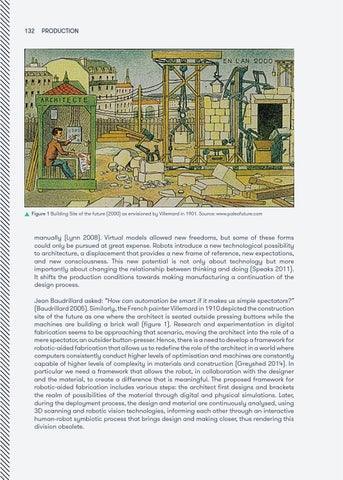132
PRODUCTION
Figure 1 Building Site of the future (2000) as envisioned by Villemard in 1901. Source: www.paleofuture.com
manually (Lynn 2008). Virtual models allowed new freedoms, but some of these forms could only be pursued at great expense. Robots introduce a new technological possibility to architecture, a displacement that provides a new frame of reference, new expectations, and new consciousness. This new potential is not only about technology but more importantly about changing the relationship between thinking and doing (Speaks 2011). It shifts the production conditions towards making manufacturing a continuation of the design process. Jean Baudrillard asked: “How can automation be smart if it makes us simple spectators?� (Baudrillard 2005). Similarly, the French painter Villemard in 1910 depicted the construction site of the future as one where the architect is seated outside pressing buttons while the machines are building a brick wall (figure 1). Research and experimentation in digital fabrication seems to be approaching that scenario, moving the architect into the role of a mere spectator, an outsider button-presser. Hence, there is a need to develop a framework for robotic-aided fabrication that allows us to redefine the role of the architect in a world where computers consistently conduct higher levels of optimisation and machines are constantly capable of higher levels of complexity in materials and construction (Greyshed 2014). In particular we need a framework that allows the robot, in collaboration with the designer and the material, to create a difference that is meaningful. The proposed framework for robotic-aided fabrication includes various steps: the architect first designs and brackets the realm of possibilities of the material through digital and physical simulations. Later, during the deployment process, the design and material are continuously analysed, using 3D scanning and robotic vision technologies, informing each other through an interactive human-robot symbiotic process that brings design and making closer, thus rendering this division obsolete.
